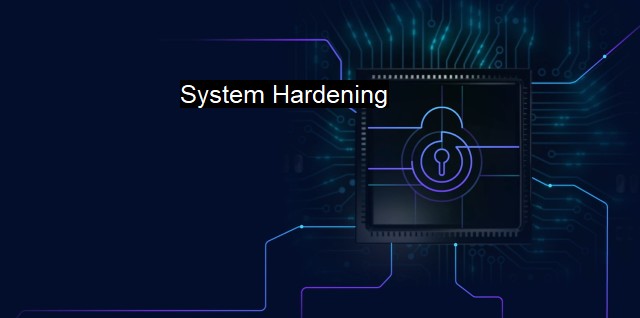What is System Hardening?
Strengthening Your IT Infrastructure: Understanding System Hardening in Cybersecurity and the Critical Role of Antivirus
System hardening is a critical facet of cybersecurity as it entails the process of securing a system by regulating its functions according to the requirements of a particular setting. It significantly reduces the potential attack surface for cybercriminals by removing unnecessary applications, disabling unwanted services, and regulating user permissions.Each technical device or software has numerous potential points of exposure or attack vectors, often exploitable by hackers. When an informational system gets installed, it typically comes with more features and functions than are necessary for normal operation. Due to these functions, there can be an unintended increase in security vulnerabilities. System hardening is the process that helps prevent these vulnerabilities by turning off unnecessary features and functions, closing open network ports, updating software, and refining various system settings for increased security.
Every unnecessary feature or functionality represents a possible avenue for exploitation – a vulnerability within the system. System hardening addresses these vulnerabilities by reducing and minimizing the possible avenues cyber threats can latch onto. It's a strategy based on the fundamental principle of adopting the lowest potential risk.
A hardening process lends to both operating systems and several computing platforms such as databases, networks, web servers, and applications. It might include measures such as timely security patches, software updates, password and user management, enabling firewall and antivirus software, encrypting data, removing guest accounts, reducing user privileges, and auditing logs for any suspicious activity.
When it comes to operating systems with several functionalities and features, the process of hardening is very much necessary to limit any exposure to external threats. Proper antivirus software can significantly complement system hardening in protecting the system from harmful viruses, worms, Trojan horses, and other sorts of malware. An updated antivirus scans the system's activity, detects and quarantines the potentially harmful software thereby helping harden the system.
One must understand that system hardening is not a one-time task; it is an ongoing project. Given that the landscape of cyber threats is ever-changing, security measures need to be continually reviewed and updated to keep pace with these changes.
The process of system hardening can bear significant advantages such as providing additional layers of security, warding off cybersecurity attacks, and ensuring organizations meet all relevant compliance requirements. there are also potential downsides due to the tedious nature of system hardening as it requires a substantial investment of time and skilled resources.
Through both passive and active measures, system hardening maintains the integrity, confidentiality, and availability (ICA) of a system, ultimately promoting optimum cybersecurity health. It acts as the first line of defense against the intrusion of cybercriminals by mitigating vulnerabilities that may act as gateways for infiltration.
On a different note, a hardened system provides users with peace of mind, as they can trust that their sensitive and private data are safely guarded against unauthorized access. Businesses, having hardening measures in place, can also confidently guarantee the protection of their client's data from external threats.
System hardening is a necessary safety measure in today’s digital age. It is a fundamental tenet of cybersecurity strategies, encompassing a wide range of tools and tactics to reduce system vulnerabilities. It requires constant evaluation and revision to maintain a secure technological environment, but with the combination of vigilant procedures and robust antivirus software, system hardening can effectively reduce the risk of cyber threats.

System Hardening FAQs
What is system hardening in cybersecurity?
System hardening in cybersecurity refers to the process of securing a computer system by reducing its vulnerabilities and strengthening its security controls. It involves configuring the operating system, applications, and network components in a way that minimizes the attack surface and enhances the system's ability to resist and recover from cyber attacks.Why is system hardening important in antivirus protection?
System hardening is important in antivirus protection because it helps to prevent the exploitation of software vulnerabilities that antivirus solutions cannot detect or block. By hardening the system, the attack surface is reduced, making it more difficult for malicious actors to gain access to sensitive data or compromise the system. This means that even if antivirus protection fails, the system will still have a strong defense against cyber attacks.What are some best practices for system hardening?
Some best practices for system hardening include: disabling unnecessary services and protocols, applying security patches and updates regularly, using strong passwords and two-factor authentication, implementing firewalls and intrusion detection and prevention systems, and configuring access controls and permissions to limit user privileges. It is also important to monitor and audit system activity to detect and respond to potential security incidents.How often should system hardening be performed?
System hardening should be performed regularly to keep up with the changing threat landscape and evolving security risks. Depending on the organization's risk tolerance and compliance requirements, system hardening can be performed on a monthly, quarterly, or annual basis. It is also important to perform system hardening whenever there are major changes to the system, such as new hardware or software installations, upgrades, or network reconfigurations.| | A | | | B | | | C | | | D | | | E | | | F | | | G | | | H | | | I | | | J | | | K | | | L | | | M | |
| | N | | | O | | | P | | | Q | | | R | | | S | | | T | | | U | | | V | | | W | | | X | | | Y | | | Z | |
| | 1 | | | 2 | | | 3 | | | 4 | | | 7 | | | 8 | | |||||||